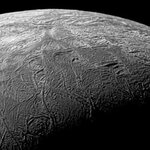Space

In May, NASA's Swift satellite imaged comet Siding Spring, which is going to play a bit of a game of chicken with Mars later this year.
"Fresh" comets like Siding Spring, which is formally known as C/2013 A1, contain some of the most ancient material scientists can study. The solid part of a comet, called its nucleus, is a clump of frozen gases mixed with dust and is often described as a "dirty snowball." Comets cast off gas and dust whenever they venture near enough to the sun.
The new optical and ultraviolet observations are the first to reveal how rapidly the comet is producing…

Pluto orbits the sun more than 29 times farther away than Earth, with a surface temperature estimated to be about 380 degrees below zero Fahrenheit.
The environment on Pluto, which 2 percent of astronomers voted on no longer being really a planet anyway, is far too cold to allow liquid water on its surface. Its moons are in the same frigid environment.
Pluto's remoteness and small size make it difficult to observe so take speculation about Charon, a moon of Pluto, having cracks in its surface and perhaps a subterranean ocean of liquid water, with a grain of otherworldly salt. In…

The standard cosmological model is the frame of reference for generations of scientists but some question its ability to accurately reproduce what is observed in the nearby universe.
Dwarf galaxies that orbit the Milky Way and the Andromeda galaxies defy the accepted model of galaxy formation, according to an international team of astrophysicists, and recent attempts to wedge them into the model are flawed, they believe.
David Merritt, professor of astrophysics at Rochester Institute of Technology, says their work pokes holes in the accepted model of the origin and evolution…

Many people care deeply about the possibility of tigers, lemurs and such like becoming extinct in the wild. I'd like to suggest we care as much about the possibility of Mars microbes becoming extinct. And more so.
So what's so special about microbes on Mars? Well first, the uniqueness. Tigers are closely related to cats. They are wonderful and remarkable creatures - and would be a tremendous shame to lose them - but basically it's the familiar tabby in another guise.
A young adult tigress from the Terai in India - Sumeet Moghe
HaloBacterium Salinarum - isolated from Lake Zuf in Wadi Natrun…
Space looks empty but unseen to the naked eye, a wind of charged particles pummels us from the Sun, carrying a magnetic field with it. Sometimes this solar wind can break through the Earth’s magnetic field, but one of the questions about how this actually occurs is difficult to answer.
When two areas with plasma (electrically charged gas) and magnetic fields with different orientations collide, the magnetic fields can be “clipped off” and “reconnected” so that the topology of the magnetic field is changed. This magnetic reconnection can give energy to eruptions on the solar surface, it can…

Will anyone own land in space? Could an individual, company or country claim the Moon? Will we have countries in space, organized by ideas and religions, and territories just as we have on Earth? Will they go to war with each other over territories, resources or ideas as they do on Earth?
Look at this carefully, and you find that there are various things about the space environment that make a difference from the way things work on the Earth. Many of our Earth based concepts may be impossible to apply in space or may need to be radically changed.
This is not just an academic question. It's…
Will anyone own land in space? Could an individual, company or country claim the Moon? Will we have countries in space, organized by ideas and religions, and territories just as we have on Earth? Will they go to war with each other over territories, resources or ideas as they do on Earth?
ook at this carefully, and you find that there are various things about the space environment that make a difference from the way things work on the Earth. Many of these Earth based concepts may be impossible in space or may need to be radically changed.
This is not just an academic question. It's already…

In 1975, physicist Kip Thorne and astronomer Anna Żytkow proposed that there are hybrids of red supergiant and neutron stars that superficially resemble normal red supergiants, such as Betelguese in the constellation Orion, but differ in their distinct chemical signatures that result from unique activity in their stellar interiors.
These Thorne-Żytkow objects (TŻOs) were hypothesized to be formed by the interaction of two massive stars ― a red supergiant and a neutron star formed during a supernova explosion ― in a close binary system. While the exact mechanism is uncertain, the most commonly…

A gamma-ray burst of light from the enormous explosion of a star more 12.1 billion years ago — shortly after the Big Bang — recently reached Earth and was visible in the sky.
Gamma-ray bursts are believed to be the catastrophic collapse of a star at the end of its life. Farley Ferrante, a graduate student in Souther Methodist University's Department of Physics, who monitored the observations along with two astronomers in Turkey and Hawaii, says they were first on the ground to observe the burst and to capture an image, using the McDonald Observatory in the Davis Mountains of West Texas…

Kapteyn's Star, named after Dutch astronomer Jacobus Kapteyn, who discovered it at the end of the 19th century, is the second fastest-moving star in the sky and belongs to the Galactic halo, an extended group of stars orbiting our Galaxy on very elliptical orbits.
With a third of the mass of the Sun, this red-dwarf can be seen with an amateur telescope in the southern constellation of Pictor.
An international team of astronomers reports the discovery of two new planets orbiting Kapteyn's Star. One of these planets orbits the star at the right distance to allow liquid water to…